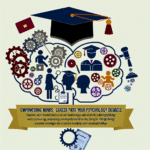
Introduction
Imagine a classroom buzzing with energy, where every student is engaged, learning effectively, and achieving their fullest potential. This vision is not just a dream; it can be an everyday reality with effective academic interventions. As educators, parents, and supporters of youth, understanding and implementing the best strategies for academic interventions is essential. In this article, we explore From Classroom to Success: Effective Strategies for Academic Interventions, aiming to illuminate methods that foster real change and academic achievement.
Understanding Academic Interventions
Before diving into specific strategies, it’s important to clarify what we mean by academic interventions. These are targeted strategies designed to help students who are struggling academically. The goal is to provide additional support and resources to ensure that all students can succeed, regardless of their starting point.
Why Are Academic Interventions Crucial?
The significance of academic interventions lies in their ability to level the playing field. Data shows that students who receive tailored support tend to perform better. A study published by the National Center for Education Statistics revealed that targeted interventions can significantly improve student outcomes, particularly in literacy and math.
Key Components of Effective Interventions
To design an effective academic intervention program, consider the following key components:
- Data-Driven Decision Making: Regular assessments can help identify students in need of intervention and assess the effectiveness of implemented strategies.
- Evidence-Based Practices: Using strategies grounded in research ensures that interventions are effective.
- Individualized Support: Tailoring interventions to meet specific student needs is crucial for success.
- Collaboration: Involving teachers, parents, and specialists fosters a holistic approach to student support.
These components will be woven throughout our discussion on strategies and methods to bridge the gap from classroom learning to lasting success.
Proven Strategies for Academic Interventions
1. Multi-Tiered System of Supports (MTSS)
Overview
MTSS is a proactive approach that offers varying levels of support based on student needs. In a practical sense, it categorizes students into three tiers:
- Tier 1: Universal interventions for all students.
- Tier 2: Targeted interventions for students at risk of academic failure.
- Tier 3: Intensive interventions for students with significant needs.
Case Study: MTSS in Action
At Westside High School, the implementation of MTSS reduced failure rates by 30% over three years. Teachers conducted regular assessments and adjusted interventions accordingly, leading to improved student outcomes.
Analysis: This case illustrates the importance of a flexible, responsive approach to academic intervention that adapts based on student needs.
2. Differentiated Instruction
Overview
Differentiated instruction is a pedagogical approach that tailors lessons to meet the diverse needs of students. This strategy is critical for effective academic interventions, as it allows educators to reach each learner where they are.
- Flexible Grouping: Students work with peers who share similar skill levels.
- Choice Boards: Students select how they wish to demonstrate their knowledge.
Case Study: Differentiated Instruction at Greenfield Academy
Greenfield Academy employed differentiated instruction across classes, allowing students to select projects aligned with their interests. The school reported a 40% increase in student engagement and performance.
Analysis: By offering choices and adapting lessons, Greenfield Academy showcased how differentiated instruction can lead to higher engagement and success rates.
3. Regular Progress Monitoring
Overview
Regularly assessing student progress is vital to gauging the effectiveness of interventions. Using formative assessments enables educators to recalibrate their approach based on real-time data.
Sample Table: Types of Assessments for Monitoring Progress
| Assessment Type | Purpose | Frequency |
|---|---|---|
| Formative Assessments | Gauges understanding during lessons | Weekly |
| Benchmarks | Measures progress against standards | Quarterly |
| Summative Assessments | Evaluates overall learning gained | End of term |
Case Study: Progress Monitoring at Lakeview School
At Lakeview School, teachers utilized formative assessments and found that students who received immediate feedback improved their test scores by an average of 15%.
Analysis: This case underscores the critical role that ongoing assessments play in informing instructional practices and improving student outcomes.
4. Family and Community Engagement
Overview
Engaging families and communities in academic interventions fosters a sense of shared responsibility for student success. When families are involved, students feel more supported.
- Parent Workshops: Educating parents on how to support their child academically.
- Community Partnerships: Collaborating with local organizations to provide additional resources.
Case Study: Community Engagement at Hilltop Elementary
Hilltop Elementary saw improved student attendance and performance after introducing parent workshops and community partnerships. The school’s reading program gained momentum through local library collaborations.
Analysis: The involvement of families and the community was pivotal in enhancing the educational landscape for Hilltop students.
5. Social-Emotional Learning (SEL)
Overview
Effective academic interventions should also address the social and emotional needs of students. Integrating SEL can create an environment conducive to learning.
Key Elements of SEL
- Self-awareness: Helping students recognize their emotions and thoughts.
- Relationship skills: Fostering healthy interactions with others.
Case Study: SEL Implementation at Riverside Academy
Riverside Academy integrated SEL into their curriculum, focusing on mental health and emotional well-being. Importantly, the school reported a decrease in behavioral issues and an increase in overall student achievement.
Analysis: This case affirms that attending to social and emotional factors substantially affects academic success.
Actionable Insights for Educators and Parents
Here are a few strategies you can implement today to facilitate academic interventions in your classroom or home:
- Utilize Data: Collect and analyze data on student performance to inform instructional decisions.
- Incorporate Technology: Use educational technology tools that personalize learning experiences.
- Foster a Growth Mindset: Encourage students to embrace challenges and view failures as learning opportunities.
- Set Clear Goals: Establish specific academic goals, making them visible and trackable for students to see their progress.
- Encourage Peer Support: Set up peer mentoring programs where students can support one another academically and socially.
Conclusion
Transitioning from the classroom to successful educational outcomes is achievable with the right academic interventions. By implementing effective strategies, educators and parents can make a significant difference in students’ academic journeys. Whether through MTSS, differentiated instruction, or social-emotional learning, each strategy provides a route to greater achievement.
The commitment to fostering these approaches highlights a dedication to empowering every student—a vital step toward enduring success. As we move forward, let’s remember that every effort counts. Together, we can transform academic interventions from mere theory into real-world practice that shapes the future of our learners.
FAQs
1. What are academic interventions?
Academic interventions are targeted strategies designed to support students who are struggling to meet educational standards, ensuring they get the help needed to succeed.
2. How can I identify students who need interventions?
Schools often use data from assessments, teacher observations, and progress monitoring to identify students who require additional support.
3. What role do parents play in academic interventions?
Parents can actively support their children’s learning by staying informed, attending workshops, and communicating regularly with teachers about their child’s progress.
4. How often should progress monitoring occur?
Formative assessments recommended frequency varies but typically should be conducted at least weekly, while benchmark assessments are usually quarterly.
5. What are some effective resources for academic interventions?
Resources may include educational technology, tutoring programs, social-emotional learning curricula, and community partnerships that enhance the support available to students.
Through insightful strategies and collective efforts, we can all be part of the journey from classroom to success. Let’s continue fostering environments where every student can thrive.

















